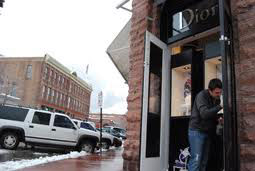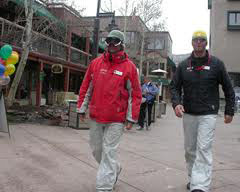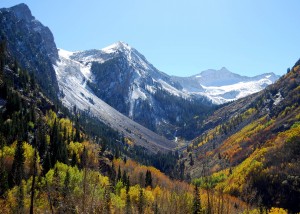
A worker tends to the entrance at Dior in Aspen, Colo., a town that has become synonymous with glitz. David Frey photo.
 Where do I lookfor the soul of Aspen? Among the snowboarders
Where do I lookfor the soul of Aspen? Among the snowboarders
chowing greasy sandwiches at Johnnie McGuire’s deli? In Gucci, where handbags sell for thousands? At the foot of Aspen Mountain, where fans rings cowbells to cheer women’s World Cup racers?
Resort towns invariably look at Aspen as the Glitter Gulch they don’t want to become. But as the resort economy sucks them in, they look to Aspen for the way out. The town they considered the devil becomes their guardian angel.
Before I end my search for the “next Aspen,” I guess I better stop in at the first Aspen.
Mayor Mick Ireland looks for the soul of Aspen on his computer screen. He pulls up a map of Aspen’s tony West End neighborhood and studies it like a palm reader. Red houses are second homes. The handful of blue ones? Primary residences. Sporadic red dots mark Aspen voters. Ireland lived here back in the ’80s when worker bees rented those old Victorians. Now, they mostly stay dark.
“You see it in a lot of resorts,” he says. “The conversion of local strongholds into these neo-Beowulfian buildings with no one living there.”
Aspen has gone farther down the surreal resort road than most. Traffic? It can take an hour just to get out of town. Mom-and-pops? They’re yielding to Brioni. A hotel costs three figures a night in high season, even at a low-end lodge.
Other resorts worry about driving out the workforce. Aspen drove away workers so long ago, those towns have driven them away even farther. Eighteen miles to Basalt. Thirty to Carbondale. Eighty to Rifle.

Aspen workers rely on government housing programs or commute from downvalley towns to survive the town's high cost of living. David Frey photo.
“The true realization was when I actually started looking for a house in 2000,” says Brian Keleher, Aspen High class of ’87, part of a generation of Aspenites who couldn’t afford their hometown. Now, he’s my neighbor in Carbondale and a Realtor.
“My wife and I said, ‘Let’s try to move to Basalt. We had a mindset of, ‘we want a single-family home. We want a yard.’ We wanted to look for something in Basalt for $150,000 and there was absolutely nothing.”
Now, he says, people look at $3 million Basalt homes and consider them bargains. The average home between Basalt and Carbondale nearly hit $1 million this year: resort prices for worker-bee towns. Aspen’s median home price was $1.8 million; Most sell for upwards of $8 million. Even some deed-restricted homes sells for $1 million. Saudi Prince Bandar just sold a guest house for $36.5 million. A princely sum for a guest house.
Aspen’s bad rap comes only partly from its cost of living, though. The rest comes from heavy regulations that cause more than just independent Westerners to bristle. Aspen and Pitkin County have one of the most robust affordable housing programs in the country. Started back in 1974, it houses 60 percent of the city’s workforce in 2,600 rental and for-sale units. The town recently forked over $18 million to buy a lumberyard for 100 more units. Hundreds more are in the works.
Pitkin County has strictly limited backcountry development. A complicated set of transferable development rights discourages sprawl and limits the size of the castles Aspen became famous for. An ambitious bus system runs all the way to Rifle. Historic preservation ordinances protect architectural gems. First-floor offices are banned downtown to spur retail.
Even towns loathe to stand in the way of the free market have decided to adopt similar measures.
“(Everybody says) ‘we don’t want to do all these things that Aspen did,’” Ireland says, “but after a while everybody does what Aspen did, but they do it too late. Like Aspen did.”
Ireland is the poster boy, and sometimes the whipping boy, for Aspen’s heavy hand. Before becoming mayor, he was a long-serving Pitkin County commissioner with a working-class hero reputation, a dishwasher-turned-bus-driver-turned-journalist-turned-lawyer who bike commutes from his deed-restricted home.
“You have to intervene to take care of yourselves,” Ireland insists. “You’ve gotta at least understand, if you don’t intervene you’ve gotta accept the consequences.”
Aspen catches heat for growth controls driving real estate prices higher, but houses are no more reasonable over in growth-friendly Vail. The prices aren’t really driven by limited land, Ireland contends. The economic forces are much bigger: a tsunami of retiring baby boomers with unprecedented wealth crashing in Aspen.
“Aspen, for a town of its size, may be the most iconic town in the world,” says Michael Miracle, who as managing editor of Aspen Sojourner magazine has a front-row seat on the town’s jet set. A former travel editor for Skiing magazine, Miracle has visited the globe’s top winter destinations.
“Aspen is probably the most cultured, sophisticated, all the while having a genuine community, of any ski town in the world,” he says.
From mining burg to cow town to hippy enclave to glitzy resort, Aspen has evolved gradually. But there was a precise turning point, Ireland maintains. It was 1986, when Congress passed incentives for real estate investment, coupled with tax cuts for the wealthy. Home prices doubled. Million-dollar homes were bought in cash. Ireland, like others, was driven from the West End. Landlords discovered renting to ski bums wasn’t their best investment. Affordable housing kept many of them in town.
“That more than anything is what allowed Aspen to maintain the strong sense of community that it has,” Miracle says.
Soaring prices continue to make things more surreal, though. The town runs the historic Wheeler Opera House for concerts and art films. When the last surviving movie theater was closing under the weight of hefty rents, the town intervened in a partnership to save it. When Aspen’s iconic bookstore went up for sale, locals pleaded with the town to save it, too. (A billionaire savior turned up instead.) Down the road, Snowmass Village officials wondered if they would have to start pumping gas when redevelopment shuttered the town’s only gas station.
As odd as it is to think of a government-run bookstore or gas station, it’s hard to imagine a resort town without those staples. Given soaring real estate values, though, property owners can make more money selling out to fractional condos. Each season brings another downtown musical chairs as businesses close, optimistic ones take their place and others shuffle toward better rents. Many businesses hang on only because of owners who aren’t worried about maximizing profits. But what happens to a resort when the nightclub closes? Or the pharmacy, for that matter?
“You have to look at the unthinkable,” says Ireland, whose historic City Hall office overlooks Gucci and Dior. A city-run dance club? Maybe.
All this wealth has been good for business. Retail is booming. Real estate is setting records. But Ireland worries about the future, when young people can’t afford to visit; when workers live so far away, it’s not worth trekking in to clean toilets.
“As soon as a place becomes cool, everybody wants to live there,” Miracle says. “Once the demand rises, that has all sorts of consequences. Suddenly, it can no longer sustain its own coolness, or its depth of character or its breadth of character. I think Aspen is confronted with that.”
Will Aspen’s popularity slacken? Not anytime soon, Miracle says. “Especially when you consider how the demand under this new affluent, elite class of people is growing.”

Beautiful landscapes like this one have made Aspen, Colo., one of the most sought-after resort locations in the country. David Frey photo.
It’s fair to ask how much the plight of resort towns matters. Glance toward the fading towns on Colorado’s Eastern Plains and Aspen’s wealth problems look enviable. But do we really want to price entire towns out of the grasp of even the well-to-do? Do we really want to rely on imported workers, legal or illegal, to do the work we can’t or won’t pay locals to do?
These are beautiful places. As Jackson Hole, Wyo.’s Jonathan Schechter says, they are the places where humanity and nature meet. Should they become gated communities for billionaires?
They are special, too, because of their own character, and often, because of the quirky characters who call them home. Aspen has a catch phrase, “messy vitality,” for those spontaneous bursts of community that happen without zoning codes. In this United States of Applebees, many resort towns are still one-offs whose vitality lies in their idiosyncrasies.
Resort towns stand at the leading edge of changes sweeping the West. Long dominated by industry and resource extraction, the region is being pulled into a lifestyle economy. Some places do it by choice. Some have it pushed upon them. But mostly, it just seems to happen as moneyed boomers seek out land, lots of land, with the starry skies above.
It’s not just the West. Florida beach towns. Appalachian hill towns. New England fishing villages. It’s just about everywhere, really, as the nation shoves industry overseas and becomes a consumer instead of a producer. It used to be, you’d have to go to a place like Aspen to find – what’s that called? A latte? Now, if you want a cappuccino you can go to the gas station. Resort towns stand are at the vanguard of the nation’s plunge into a service economy.
So where’s the next Aspen? Everywhere I went. Park City. Ketchum. Big Sky. Jackson Hole. And lots of places I didn’t go. Their issues are all the same.
Or maybe nowhere is the next Aspen, if these places, in the face of change, fight to keep the qualities that make them unique and some of the most sought-out places in the world.

